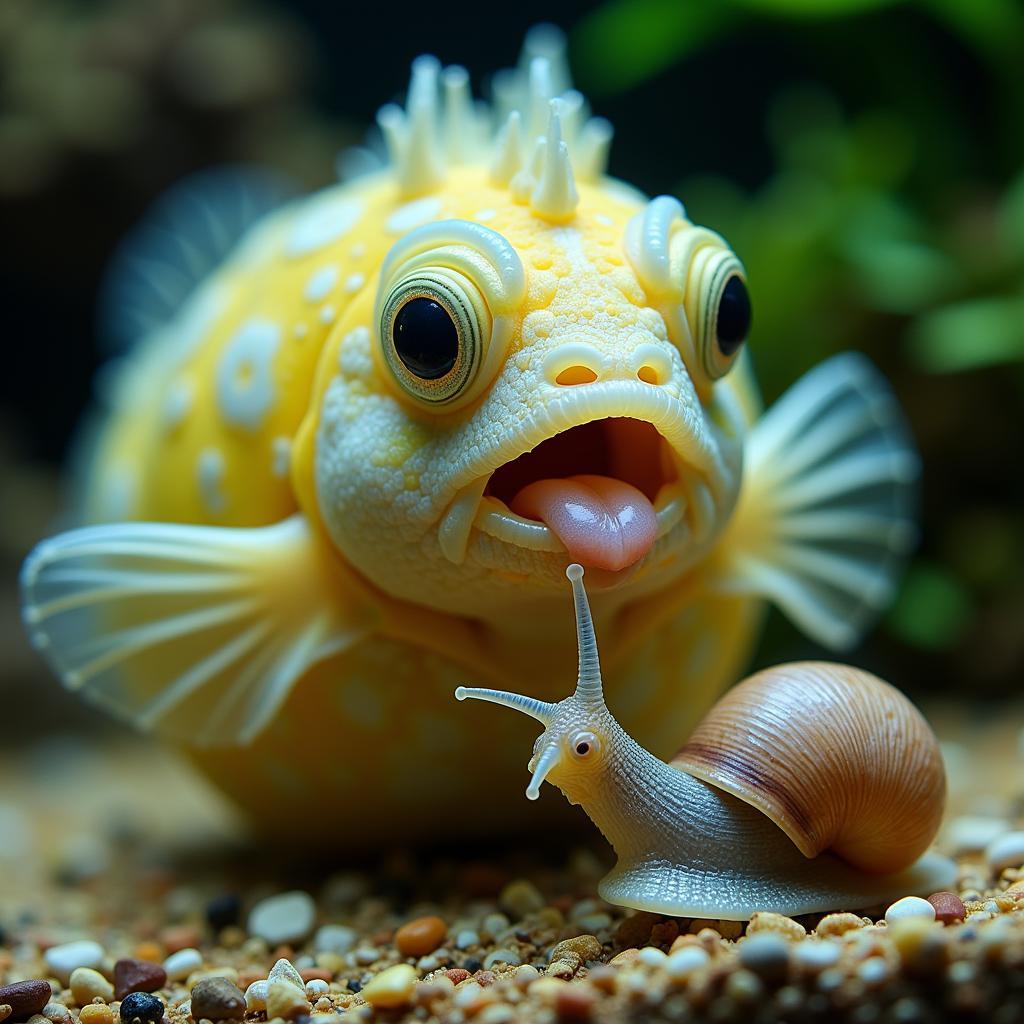Pea puffer fish, those adorable miniature aquatic dynamos, require a specialized diet to thrive. Understanding what Pea Puffer Food entails is crucial for responsible ownership. From snails and bloodworms to the occasional treat, this guide will delve into the dietary needs of these fascinating creatures.
What Do Pea Puffers Eat in the Wild?
In their natural habitat, pea puffers are opportunistic carnivores. Their diet primarily consists of small invertebrates like snails, crustaceans, and insect larvae. They are known for their powerful beaks, which allow them to crush the shells of their prey. This natural diet provides the essential nutrients they need to stay healthy and active.
 Pea Puffer Eating a Snail
Pea Puffer Eating a Snail
The Best Pea Puffer Food for Your Aquarium
While mimicking their wild diet is ideal, providing variety is key to a healthy captive pea puffer. Here are some of the best food options:
- Snails: A staple in the pea puffer diet, snails provide essential calcium for healthy beak growth. Offer a variety, including Malaysian trumpet snails, ramshorn snails, and pond snails.
- Bloodworms: These are a nutritious and palatable treat, offering a good source of protein. However, they shouldn’t be the sole food source.
- Daphnia and Brine Shrimp: These small crustaceans are an excellent supplemental food, especially for young pea puffers.
- Mysis Shrimp: Another great source of protein, mysis shrimp are readily accepted by most pea puffers.
How Often Should You Feed a Pea Puffer?
Pea puffers have a high metabolism and should be fed small amounts multiple times a day. Young puffers should be fed 2-3 times daily, while adults can be fed once or twice a day. Overfeeding can lead to obesity and water quality issues.
What About Pellets for Pea Puffers?
While some pea puffers may eventually accept pellets, they are not ideal. These fish are not naturally inclined to eat processed foods. Focus on offering live or frozen foods to ensure they receive the proper nutrients.
Are There Any Foods to Avoid?
Yes, certain foods should be avoided:
- Tubifex worms: These can carry parasites and diseases.
- Feeder fish: While some hobbyists use feeder fish, it’s not recommended due to the potential for disease transmission and ethical concerns.
- Overfeeding any food type: This can lead to health problems and negatively impact water quality.
Expert Insights on Pea Puffer Food
Dr. Amelia Rivers, a renowned aquatic veterinarian, advises, “A varied diet is crucial for pea puffer health. Think of snails as the cornerstone, supplemented with other invertebrates.” She also emphasizes the importance of monitoring your puffer’s beak growth, adding, “Regular snail consumption helps keep their beaks trimmed naturally.”
Professor Timothy Clark, a marine biologist specializing in pufferfish, adds, “In the wild, pea puffers consume a wide range of small creatures. Replicating this diversity in captivity is key to their well-being.”
Conclusion
Providing the right pea puffer food is vital for their health and longevity. By focusing on a varied diet rich in snails, supplemented with other appropriate invertebrates, you can ensure your spiky friend thrives. Remember, a healthy pea puffer is an active and engaging member of your aquarium community.
FAQ
- What if my pea puffer refuses to eat snails?
- Can I breed snails for my pea puffer?
- How do I know if my pea puffer is overfed?
- What are the signs of a healthy pea puffer?
- How can I encourage my pea puffer to eat a variety of foods?
- Do pea puffers need supplements?
- What type of water conditions do pea puffers prefer?
Need support? Contact us at Phone Number: 02437655121, Email: minacones@gmail.com Or visit us at: 3PGH+8R9, ĐT70A, thôn Trung, Bắc Từ Liêm, Hà Nội, Việt Nam. We have a 24/7 customer service team.